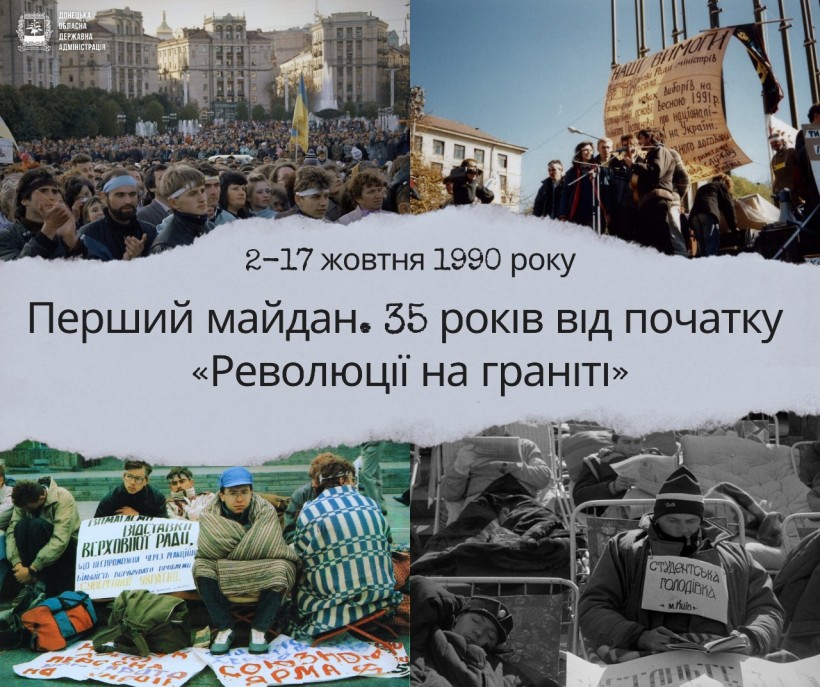
In the early 1990s, parliamentary elections were held in Ukraine, where a quarter of the seats were won by national democratic candidates. The majority, 239 deputies, were communists. Despite this, in July 1990, the Verkhovna Rada of the Ukrainian SSR adopted the Declaration of State Sovereignty of Ukraine, which provided for broad political and economic autonomy.
The document stipulated that in the future Ukraine would join the renewed Soviet empire by signing a new "union treaty." The Communists saw this as a concession that would prolong the life of the Union. At the same time, the national democratic forces considered the Declaration to be the first step towards full independence and organized numerous rallies calling for the rejection of the new Union Treaty.
Ukrainian youth did not find such actions very effective. Guided by their peers, who played an important role in the events of the "velvet revolutions" in Eastern Europe in the late 1980s, which led to the overthrow of communist regimes, Ukrainian students were looking for more effective tools that would allow them to get rid of the dictates of the Communist Party and bring Ukraine's independence closer. The hunger strike was recognized as the most optimal form of protest, which, according to the organizers, would allow them to achieve their goals. The participants were ready to make the ultimate sacrifice - to starve to death. Therefore, the idea of sacrifice became one of the cornerstones of the action.
The Soviet system severely punished dissent. Being prepared for arrests, the protesters relied on the idea of non-violent resistance. According to the organizers of the action, the hunger strike was supposed to become an emotional factor that would raise Ukrainian youth to go on a nationwide strike for the sake of the demands put forward by the hunger strikers.
This is how the events that went down in history as the "Revolution on Granite" began. They became a catalyst for changes that contributed to the restoration of Ukrainian independence, the struggle for which lasted throughout the twentieth century: from the proclamation of the Ukrainian People's Republic, the activities of the OUN and UPA, the Sixties, dissidents, to the Ukrainian Maidans, among which the first mass protest was the events of October 1990 on the granite slabs of the center of Kyiv.
The action was planned to be held near the Verkhovna Rada building. However, on the morning of October 2, police units surrounded the building. Some of the protesters who went to October Revolution Square decided to start their protest there. In the evening, a tent city appeared on the main square of Kyiv.
The students on hunger strike put forward five demands:
- Resignation of Vitalii Masol, Chairman of the Council of Ministers of the Ukrainian SSR.
- Early dissolution of the Verkhovna Rada of the Ukrainian SSR and the appointment of new elections on a multi-party basis in the fall of 1991.
- Preventing the signing of a new Union Treaty.
- Return to Ukraine of soldiers serving in the army outside the country and ensure that young men who were drafted to serve in the republic would serve in the country.
- Adoption of a law on the nationalization of the property of the Communist Party of the Ukrainian SSR and the Leninist Communist Youth Union of Ukraine (LKSMU).
- On October 15, 1990, a general student strike took place in higher education institutions. About one hundred thousand students, workers, and ordinary citizens gathered on the Maidan, some of whom marched to the building of the Supreme Soviet of the Ukrainian SSR. Several dozen protesters broke through the police cordon and organized another tent city with hunger strikers on the square in front of it. Students blocked the Red Building of Taras Shevchenko University of Kyiv. On the same day, Oles Doniy voiced the protesters' demands from the rostrum of the Verkhovna Rada of the Ukrainian SSR, and in the evening, the leaders of the action spoke live on the Central Television of the Ukrainian SSR. This was the first official recognition of the students' protest in the country's information space
- Already on October 17, the Verkhovna Rada of the Ukrainian SSR adopted a resolution "On Consideration of the Demands of Students on Hunger Strike in Kyiv since October 2, 1990": 314 votes in favor, 38 against. Almost all of the youth's demands (except for the early termination of the Verkhovna Rada of the Ukrainian SSR) were met.
The "Revolution on Granite" was a turning point in the establishment of Ukraine's independence, and in the early 1990s, the younger generation demonstrated their desire and defended their right to live in a free democratic state. Youthful enthusiasm, multiplied by a clear and well-thought-out organization of the actions, made it possible to demonstrate the remarkable political potential of the Ukrainian youth movement, which forced both the then Communist Party authorities and experienced opposition figures to reckon with themselves. The acts of civil disobedience that swept through Ukraine in October 1990 laid down the traditions of democratic protests, which were further expressed by the Orange Revolution and the Revolution of Dignity.